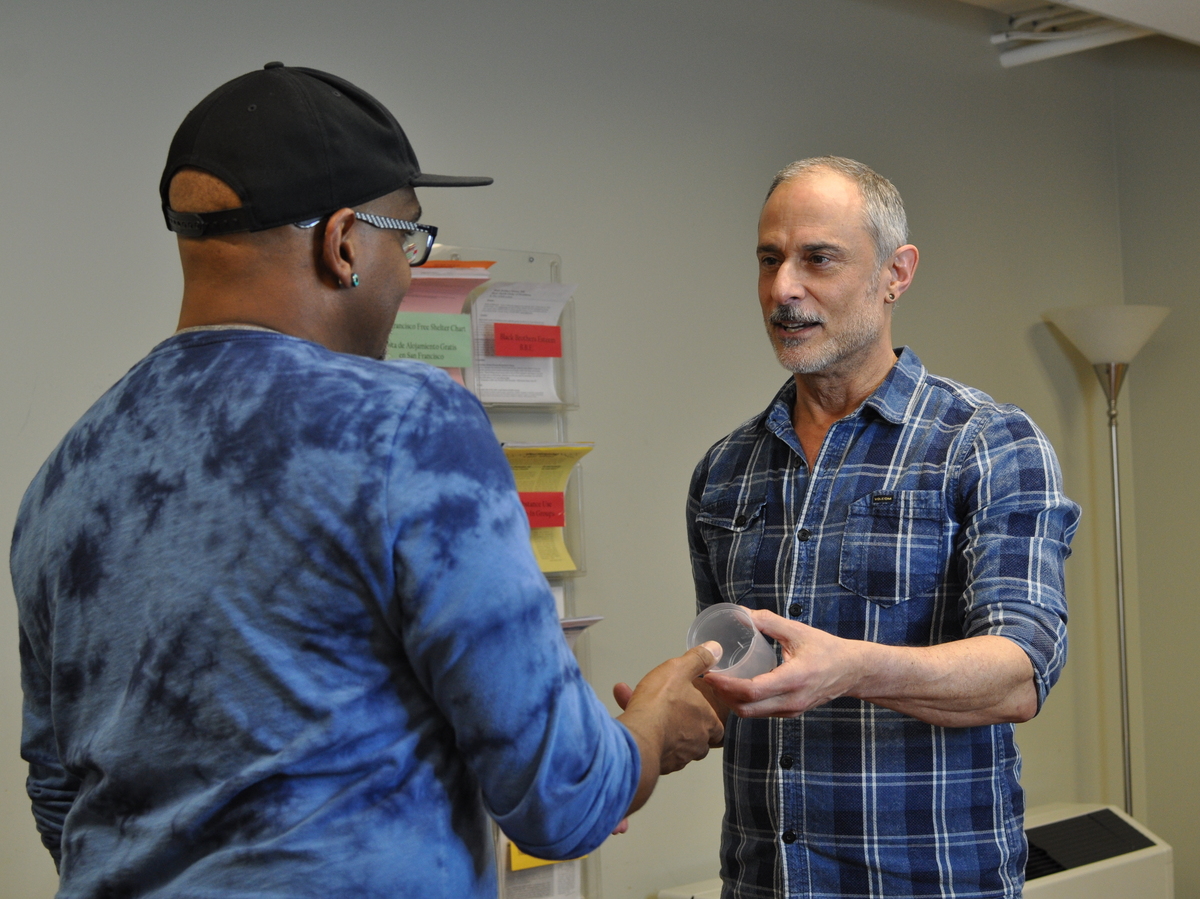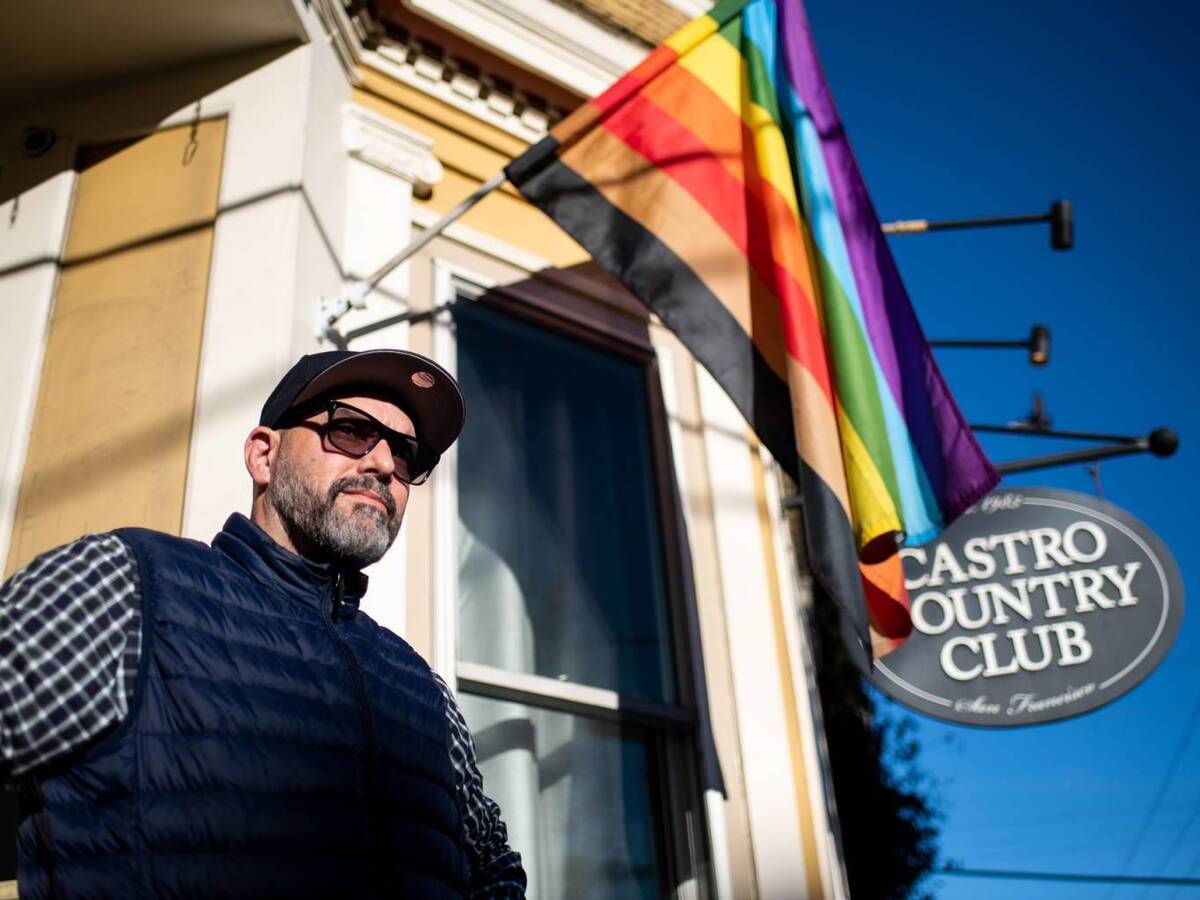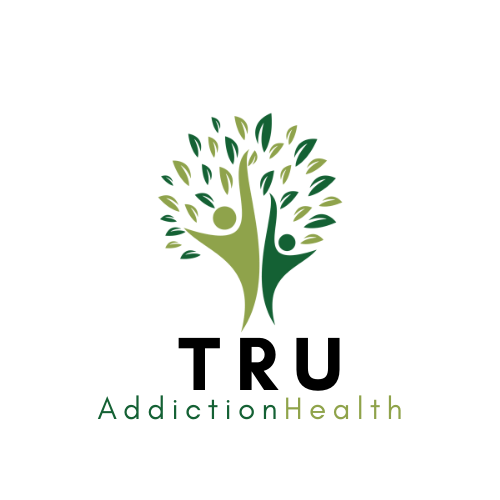
At the San Francisco AIDS Structure, staff members Tyrone Clifford (left) and Rick Andrews (ideal) show how a contingency management see usually starts, with an individual getting a specimen cup for a urine sample. If the sample tests unfavorable for meth or cocaine use, the individual has an reward dollar quantity included to their “bank” which can later on be traded for a present card.
Christopher Artalejo-Price/San Francisco AIDS Structure.
conceal caption
toggle caption
Christopher Artalejo-Price/San Francisco AIDS Structure.

At the San Francisco AIDS Structure, staff members Tyrone Clifford (left) and Rick Andrews (ideal) show how a contingency management see usually starts, with an individual getting a specimen cup for a urine sample. If the sample tests unfavorable for meth or cocaine use, the individual has an reward dollar quantity included to their “bank” which can later on be traded for a present card.
Christopher Artalejo-Price/San Francisco AIDS Structure.
When Billy Lemon was attempting to kick his methamphetamine addiction, he went to a drug treatment program at the San Francisco AIDS Structure 3 times a week and peed in a cup. If it checked unfavorable for meth, he got paid about $7.
” For someone who had actually not had any genuine cash– without devoting felonies– that looked like a cool thing,” states Lemon, who was jailed 3 times for selling meth prior to beginning recovery.
The payments were part of an official addiction treatment called contingency management, which incentivizes drug users with cash or present cards to remain offdrugs At the end of 12 weeks, after all his drug tests returned unfavorable for meth, Lemon got $330. However for him, it was about more than simply the cash. It was being informed, great task.

This story was produced in collaboration with Kaiser Health News.
&& nbsp
.
conceal caption
toggle caption
& nbsp.
“It was the first chance where I resembled, I have self-respect, still. It’s buried. This individual sees it and wants to offer me 7 dollars, simply to take care of myself. That was really inspiring,” he states.
As overdoses and public health costs associated to meth and cocaine continue to spiral in California, state authorities are desperate for more effective treatment options and are pursuing legislation and attractive to federal regulators to make contingency management more extensively readily available. Washington, Montana, and West Virginia are likewise checking out comparable strategies.
Due to the fact that research studies reveal contingency management works. The concepts of the treatment– favorable support techniques, mostly– are used extensively in weight-loss, physical fitness programs, and in households, as moms and dads coax their kids into embracing great behaviors, instead of penalizing them for bad behaviors.

Billy Lemon, 50, kicked his meth routine more than 9 years back after participating in a “contingency management” program for meth and cocaine users at the San Francisco AIDS Structure. For every single unfavorable drug test, he made a percentage of cash. Lemon now runs the Castro Nation Club, a recovery center in San Francisco.
Beth LaBerge/KQED.
conceal caption
toggle caption
Beth LaBerge/KQED.

Billy Lemon, 50, kicked his meth routine more than 9 years back after participating in a “contingency management” program for meth and cocaine users at the San Francisco AIDS Structure. For every single unfavorable drug test, he made a percentage of cash. Lemon now runs the Castro Nation Club, a recovery center in San Francisco.
Beth LaBerge/KQED.
Research study reveals contingency management is the most effective treatment for meth or cocaine addiction, specifically when integrated with otherbehavioral therapy At the San Francisco AIDS Structure, 63% of people who took part in the program in 2019 stopped utilizing meth totally, and another 19% decreased their use.
The Department of Veterans Affairs has actually relied on the therapy to reward 5,600 veterinarians over the last ten years. Of the 73,000 urine samples gathered in the VA program, 92% checked unfavorable for drugs, according to Dominick DePhilippis, a clinical psychologist at the Philadelphia Center for Substance Addiction Treatment & & Education who assisted introduce the VA’s program.
” Patients typically come to treatment ambivalent about modification. Why? Since substance use is so sexy. It provides effective, instant support,” DePhilippis states. “Whereas recovery, its instant effects, are typically undesirable: withdrawal symptoms, a clear-eyed view of the ravaged landscape that is one’s life.”
Contingency management welcomes this obstacle head on, he includes, by using instant benefits and support for abstaining. The little payments or rewards objective to rewire the brain’s benefit system, so the individual looks for the cash or present card to get a dopamine release, rather of meth or coke.
” You resemble, ‘Oh! Oh! I can feel great without the everyday use of thatsubstance Let me try and go another week,'” states Lemon. “And after that all of an unexpected, you’re at 90 days and you’ve really made a modification.”
Regardless of its efficiency, the treatment is questionable. Critics have actually scoffed at the concept of paying drug users not to use drugs, calling it dishonest or a kickback Many insurance providers do not cover it. Neither do state Medicaidprograms The feds normally prohibited them from offering financial rewards to patients, as a security versus scams and waste, and state authorities have actually translated that guideline as forbiding repayment for contingency management.
California will try to scale up an effective treatment for stimulant addiction
However as the drug epidemic continues to get worse throughout California and the country, with overdoses from stimulants like meth tripling in current years, state authorities are questioning those policies and pressing for modifications. Critics are softening their position. A costs now on the guv’s desk– SB 110— would enable the state’s Medicaid program to pay for contingency management services, with the objective of motivating more drug treatment centers to provide it.
” We require to welcome this shown, effective approach to meth addiction, make it plainly legal and begin compensating for it, so we can resolve this health epidemic,” says state Sen. Scott Wiener (D-San Francisco), who sponsored the costs.

Wiener states he marvelled to see the costs pass the California legislature with near consentaneous, bipartisan assistance.
” The Republicans enjoy it,” he states. “I didn’t believe they would, however they really like it due to the fact that there’s an abstaining element to it: we pay you cash and you avoid utilizing.”
The state’s Department of Health Care Solutions, which runs California’s Medicaid program, is likewise on board. Department leaders have actually currently asked federal regulators for specific authorization to deal contingency management through a statewide pilot task, and the feds appear poised to grant it.
Up until rather just recently, the federal government has actually hesitated to unwind guidelines that disallow public health programs from offeringcontingency management In 2020, throughout the Trump administration, treatment professionals asked the U.S. Department of Health and Human Solutions to waive the guidelines for 2 years, however the company declined
” It’s clear the [Trump] administration had very little interest in looking at proof or science, on a wide range of subjects,” states Laura Thomas, director of damage decrease policy at the San Francisco AIDS Structure, which assisted sponsor the costs.
The Biden administration, on the other hand, particularly specified in its 2021 drug manage policy that a person of its primary top priorities is to “determine and address policy barriers associated to contingency management.”
As stimulant overdoses skyrocket, California looks to a tested behavioral intervention
The requirement is urgent, discusses Dr. Kelly Pfeifer, deputy director of behavioral health at the California Department of Health Care Solutions. In 2020, more Californians passed away from meth and cocaine overdoses than from fentanyl overdoses, and stimulant abuse is creating chaos on California’s prisons and courts, foster care, and hospitals.
” Which are undoubtedly not just ravaging to the individual and the family, however really costly for our health care system,” Pfeifer states.

There’s likewise an increasing sense of despondence amongst stimulant users, she includes, due to the fact that of the absence of effective, readily availabletreatments For opioid addiction, there are now 3 FDA-approved medication therapies: methadone, buprenorphine and naltrexone. For meth and coke, there are no such medications.
Making contingency management more extensively readily available would make more people ready to seek treatment, Pfeifer states.
” Since people will see success stories,” she states. “They’ll see buddies and family getting treatment and getting help and improving.”
One downside of contingency management is that the benefits may decrease when the active treatment ends. Because of that, some medical professionals think the reward treatment need to be provided continually, in the very same method that medication therapies for opioid use disorder are in some cases recommended forever. However brand-new research study suggests the benefits may last longer than formerly believed. In an evaluation of 23 formerly released trials, scientists at the University of Connecticut discovered that people who took part in contingency management were 22% most likely to be abstinent 6 months after treatment ended than people who got other treatments.

For Billy Lemon, contingency management was simply what he required to boost his recovery, and to perseverein residential rehab When he squandered all his reward payments, he used the $330 to purchase himself a brand-new cellular phone.
“ Since up till then, Breaking Bad-style is burner phones,” he states, referring to the pre-paid non reusable phones drug sellers use, then dispose of, to prevent detection by the cops. “My number was never ever the very same.”
Now, 9 years later on, he’s still sober – he runs the Castro Nation Club, a recovery area in San Francisco – and the number he got with his brand-new phone is still his number.
“ It’s a good tip of what making great choices for yourself can develop into,” he states.
This story originates from NPR’s health reporting collaboration with KQED and Kaiser Health News.
